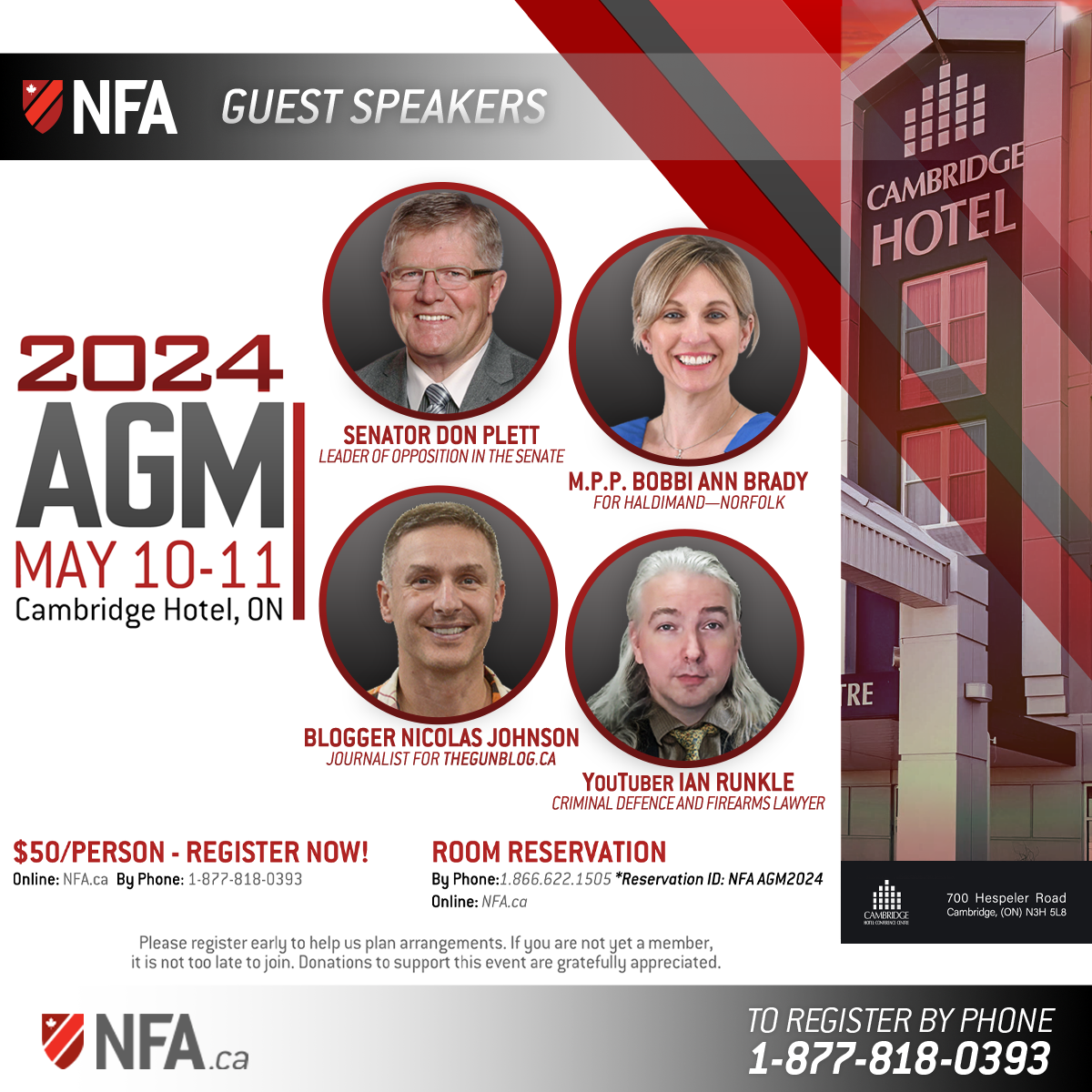Reloading Update #1
New! Sept 2004: Department of Natural Resources Update
The federal Department of Natural Resources is reviewing proposals with regard to smokeless powder, black powder and reloading of ammunition.
The civil servants in this department have asked for input from firearms owners, ammunition re-loaders and other interested parties.
In bold in this paper are the ideas which have come forward though the Department of Natural Resources which they have requested comments from individuals.
The National Firearms Association has provided some information following each of these proposals.
We encourage you to write to:
Juri Kasemets
Manager, Eastern Division
Explosives Regulatory Division
Natural Resources Canada1505 Barrington Street, Halifax, Nova Scotia, B3J 3K5
Tel: (902)426-9486
E-mail: jkasemet@nrcan.gc.ca
We would ask that you also send a copy of your message to the National Firearms Association ( This email address is being protected from spam bots, you need Javascript enabled to view it) and the Canadian Shooting Sports Association along with your Member of Parliament.
The National Firearms Association suggest that one of the goals the Department of Natural Resources should be seeking is greater consultation with industry experts and firearm groups — this would duplicate the process that they use in other areas.
Your letters adding this suggestion would be helpful.
Here is the text of the letter we received from the Department of Natural Resources on this topic.
“Thank you for your email expressing your concerns over proposed changes to regulations under the Explosives Act relating to handloading of ammunition. The proposals that you refer to were released to start the consultation process. A newsletter has recently helped spread the information to the reloading community.
There is no connection between these proposals and the recently passed Public Safety Act (Bill C-7; formerly C-42). Proposals for that Act were aimed at import, export and in-transit controls over “inexplosive ammunition components”. These proposals were withdrawn due to objections from the firearms community.
The proposed regulations on handloading relate mainly to safety, not security. Addressing each of the proposals:
- Handloading in detached dwelling only. The accidental ignition of 5 kilograms (kg) of black or smokeless powder can cause a fireball several metres across. This would undoubtedly initiate a rapid and intense fire in a normal room. We do not believe that residents in a multi-unit dwelling should be subject to the risk.
- No more than 5 kg of propellant to be stored within a dwelling. According to handloading tables this is sufficient for 1500 (shotgun) to 20,000 (pistol) loads. This amount seems adequate.
- No handloading within 15 metres of a neighbouring dwelling. Again, this proposed change relates to protecting neighbouring properties from the risks and hazards associated with ammunition loading activities.
- All propellants to be given a United Nations designation. There is nothing new here. All explosives made in or imported into Canada must be authorized and classified under the UN system.
“The Explosives Act prohibits the manufacture of explosives (including ammunition) anywhere except in a licensed factory – unless exempted by regulations. We have for many years made regulations to exempt handloaders from this prohibition and, thus, avoid the expense of acquiring a factory licence.
“We are looking for constructive feedback on these proposals. Consultation with stakeholders is part of the regulatory process. When the proposals are fully developed they will be posted on our website (www.nrcan.gc.ca/mms/explosif/index.htm).
Please tell us what you think.”
Here are the National Firearms Association’s
COMMENTS ON EXPLOSIVES ACT PROPOSALS
1. Handloading in detached dwelling only. The accidental ignition of 5 kilograms of black or smokeless powder can cause a fireball several metres across. This would undoubtedly initiate a rapid and intense fire in a normal room… We do not believe that residents in a multi-unit dwelling should be subject to the risk.
Comment: Once again, the government is equating smokeless powder (classed as a flammable solid for transportation purposes, including transportation by air) and black powder (classed as a low explosive). It is very inaccurate to try to claim that those two have any great degree of equality.
The word “undoubtedly” indicates that no testing of this theory has been done.
In real-world terms, there is virtually no way that anyone could ignite “5 kilograms” of smokeless powder, and get “a fireball several metres across. If a 1-pound can or cardboard canister of smokeless powder is ignited:
(a) No explosion takes place, because smokeless powder does not “explode” unless contained in a very strong container, such as a closed steel pipe or a firearm chamber. It deflagrates, decomposing into hot gas. Only if there is nowhere for that hot gas to go can one get anything remotely resembling an explosion.
(b) The deflagration takes place only at the surface of the smokeless powder, which severely limits the rate at which the hot gases are produced.
(c) The deflagration does not propagate to other 1-pound containers of smokeless powder that are physically touching the deflagrating can or cardboard canister.
The idea that “a fireball several metres across” can be produced using smokeless powder kept in either normal containers or a reloading powder measure is nonsense, and will bring the Department of Natural Resources — Explosives Branch into disrepute if published.
Black powder, on the other hand, is a low explosive. If ignited, it burns, turning a mixture of three chemicals into hot gases at a very much faster rate than anything that can happen with smokeless powder. The rate of burning can be accelerated by containing the hot gases to increase the pressure, but when burned in the open, or in a normal metal can or cardboard canister, there is no explosion. There is just a “Whuff!!” As the black powder burns, with great rapidity, but without explosive force.
Black powder, today, is used almost exclusively for muzzle-loading firearms. It is therefore kept and stored in metal cans, and transported in metal cans. Such a can is never opened in any place but a shooting range or in the field for hunting, where the black powder is used for loading muzzle-loading firearms. There, it may be transferred into a powder horn or a reloading flask. The Canada Firearms Safety Course covers black powder and safe handling proceedures.
2. No more than 5 kg of propellant to be stored within a dwelling. According to handloading tables this is sufficient for 1500 (shotgun) to 20,000 (pistol) loads. This amount seems adequate.
If handloaders loaded only one type of cartridge, this claim might have a grain of validity. However having accurate information from individual reloaders and industry experts can help make sure that e department is more aware of the requirements of reloaders. .
A handloader usually loads a variety of ammunition — some pistol cartridges, some rifle cartridges, and some shotgun cartridges. A single type of smokeless powder usually cannot be used for all the pistol cartridges, or all of the rifle cartridges, or all of the shotgun cartridges. The deflagration rate of the smokeless powder used for one calibre of rifle cartridge, for example, renders it quite unsuitable for another calibre of rifle cartridge.
In reloading ammunition, it is very necessary to use the right type of smokeless powder for each type of cartridge being reloaded. The Department of Natural Resources — Explosive’s Branch’s simplistic position, as stated above, makes it very obvious that government is attempting to regulate an activity it knows startlingly little about, by proposing regulations based on fallacies.
3. No handloading within 15 metres of a neighbouring dwelling. Again, this proposed change relates to protecting neighbouring properties from the risks and hazards associated with ammunition reloading activities.
This proposal is apparently intended to prevent ammunition reloading anywhere within any urban or town setting. The slightest bit of thought will show that there is rarely a 15-metre gap between any normal house and the house next door. This is not a “safety” measure, it is an attempt at disguised prohibition of nearly all reloading activities. As such, it will be fought — by demanding that the government produce records of any and all incidents where any reloading activity has caused damage to any house other than the house where the reloading activity was taking place.
In order to get maximum research data from such a search of real data, a demand will also be made that the government also publish records of all reloading incidents that caused damage to the house in which the reloading activity in which the reloading activity was taking place.
The National Firearms Association is quite confident that such records will prove that the government is trying to regulate — with rather savage prohibitions — matters that have not historically been a problem even with little or no regulation. This is, apparently, a set of proposals not based on knowledge of what is required.
4. All propellants to be given a United Nations designation. There is nothing new here. All explosives made in or imported into Canada must be authorized and classified under the UN system.
If there is “nothing new here,” why is this proposal being made? What is meant by “authorized…under the UN system”? Is this yet another giveaway of Canadian sovereignty, for no discernable purpose?
Great reference material to utilize in your replies could include Hatcher’s Notebook, by Major General Julian S. Hatcher U.S.A. Ret. ISBN Number: 0-8117-0795-4
The National Firearms Association asserts that rather than another level of increased regulation — that what is really needed is an educational campaign involving industry, government, and the National Firearms Association and other related stakeholders.
Perhaps, the Department of Natural Resources –Explosives Branch could help establish a new standard where firearm owners, firearm groups, industry, and the federal department could work together.
The National Firearms Association would support such a move.



